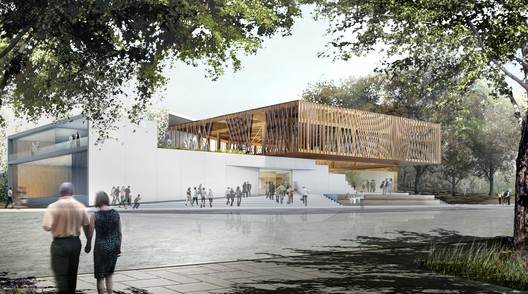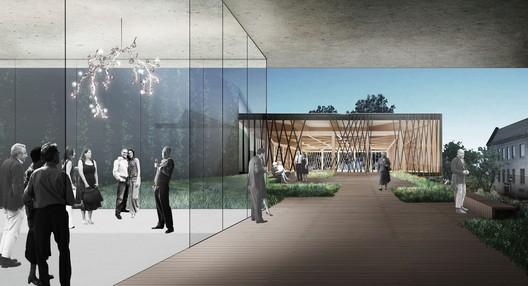
Studio Gang has broke ground on the new home for Chicago’s beloved Writers’ Theatre. Situated on the sloped Tudor Court site of the Glencoe Woman’s Library Club, the glass encased timber structure will be a theatrical spectacle, as the main performance space's second story catwalk is designed to peer through the transparent facade.
“Our process has been built around the creative team dialogue with Writers Theatre, its audiences, and the community, and we could not be more excited to celebrate this milestone today while looking forward to the ideas that will soon become a built reality in 2016,” said Jeanne Gang. “The design of Writers Theatre’s first purpose-built theatre reinforces their important mission and vision to maximize the feeling of intimacy between actors and audience within the park-like setting of downtown Glencoe.”
New renderings and more information from the architect, after the break.

From the architect: Timber trusses structure the lobby, through which the 250-seat theater and flexible 99-seat theater are entered. At night, the lobby - visible from afar - is envisioned as a lantern that announces the Theatre and is poised to become Writers’ Theatre marquee.

The lobby is conceived as a gathering space that provides access to the stages and public spaces of the theatre. The spacious lobby will function as a central social gathering area for Writers’ Theatre’s audiences and also serve the dual purpose of providing space for pre- and post-show discussions, staged readings, education and family programming, community events, and concerts and lectures. Above, its second floor gallery circumscribes the space, providing additional viewing and people-watching positions.

Writers’ Theatre’s hallmark is audience and actor immersion, and thus a feeling of intimacy inside the 250-seat theater is paramount. Designed with input from Writers’ Theatre’s audience and artists, its thrust stage is surrounded by three seating banks, two of which are free standing. By detaching the seating banks from the exterior wall, the design intensifies the intimacy of the stage by extending the actors’ space all the way around and behind them. Audience members are literally sitting on the stage and drawn into the world of the play.












